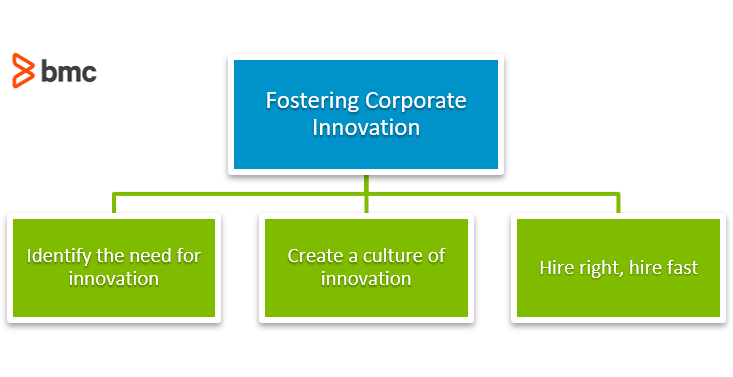Innovation allows organizations to sustain growth and business improvements over a continuous and consistent basis. Innovation may appear in the form of a new:
- Products
- Features
- Operational processes
- Business model
Many forms of innovation depend upon your company’s ability to execute creativity and optimize business processes. Product improvement often appears as a popular form of innovation.
But, new products tend to lose impact soon after mass adoption in the market, which is particularly fast-paced for products perceived as truly innovative. Why? All your competitors want in, too.
As a result, organizations need to resort upon alternative forms of innovation that can sustain market disruption over the long term.
For instance, business model innovation tend to solve key problems in the market for a prolonged time period and are readily adopted among leading enterprises to sustain growth. Consider the examples of AirBnB and Uber. Both organizations switched their business model to a crowd-sourced, platform-based service delivery model. Fostering this form of corporate innovation allowed these startups to emerge as the global enterprises they are today.
In this article, we’ll take a look at corporate innovation. Whether a small company, a government organization, or an international enterprise, corporate innovation is mandatory.
(This article is part of our Innovation in The Enterprise series. Use the right-hand menu to navigate.)
What is corporate innovation?
Innovation can be hard to define. At its best, innovation is the process of transforming ideas and inventions for a new purpose or audience. Applied to any corporate setting or company, these new ideas will arrive in many forms—products, services, and process improvements—that deliver tangible benefits.
The goal of innovation is to design intentionally in order to satisfy a sustained need or specific time period.
Corporate innovation likely also transforms executing existing ideas and inventions to yield tangible improvements. It’s not just adding new features, but considering any product in a holistic way: perhaps it’s origin story which drove initial development is no longer a valid or worthy business case.
Can you innovate a product to enhance it, bring it forward, rethink it all together?
One of the most critical elements of innovation is the creativity behind this transformation. Of course, that creative potential is immediately hindered by inevitable challenges, which can stop any innovation conversation before you even utter the word “innovate”.
Different environment lead to different set of challenges. These challenges may be unique to a particular set of entities but not limit the same innovation to be executed by other entities that do not face the same challenges. This is exactly why small startups such as AirBnB and Uber were able to adopt a more agile new business model to deliver the same services as the housing and taxi industry without the obstacles facing their larger counterparts in pursuing the same markets.
How to foster corporate innovation
So, let’s define corporate innovation as any innovation process within a corporate environment. The goal of innovation is obvious: staying on top of your competition. But the execution is much trickier to get right.
Here’s how organizations can foster corporate innovation:

Identify the need for innovation
The first step toward corporate innovation is to acknowledge the continuous need for innovation.
While many business leaders may announce company vision and philosophy to innovate and disrupt the market, actual business resources may not reflect this idea. So, start with these activities:
- Quantify and compare the resource investments on regular business operations versus innovation projects.
- Evaluate the performance of innovation-based growth enablers and understand how any gap could be addressed with future business plans.
If a significant component of the business plan is not attributed to disruptive initiatives through business model, product or process based innovation strategies, it is likely that the workforce is still adopting a low-risk business strategy focused on stable growth instead of market disruption via innovation initiatives.
Create an innovation culture
Organizational culture defines the ability of the workforce to engage in initiatives that can lead toward corporate innovation. Business leaders and C-suite executives should be the first to embrace positivity and optimism toward innovative ideas. This is embodied in the term innovation culture.
That means that any organization demanding innovation must give its workforce the tools they need to work creatively and openly:
- Freedom
- Tangible resources, including budget, supplies, and even talent
- Encouragement, early and often
Failure should not prevent teams from testing new strategies and feature development. Instead, reward failures. Proudly recognize that new ideas can help bring the best out of the workforce and ultimately help execute ideas that can truly transform into disruptive corporate innovation—but not every single idea gets an A+ right out of the gate.
Large enterprises employing a diverse workforce have a better opportunity to develop cross-functional teams and change the work environment so that the ideas and skills are complemented toward execution. A culture that allows employees to challenge existing strategies, processes, and assumptions is likely to yield innovative ideas.
Unfortunately, it’s quite likely that, despite all the available talent and resources, your existing organizational culture stifles the innovation process by enforcing unnecessary limitations in the way employees can work, collaborate, or even think.
(One sign of this? If leadership is telling the organization to seek innovation in one specific product area or tool. Instead, promote innovation widely, so that ideas that aren’t immediately relevant can still offer potential.)
Hire right, hire fast
The workforce is inherently the most critical resource for corporate innovation. The talent gap in the industry is already at a sharp rise. The best performing organizations lure and retain the best talent.
For organizations pursuing corporate innovation, hiring the best innovators faster than their competition is vital to lead the race toward innovation. Specifically, individuals working in the various domains of research and development (R&D) at research, academic, or scientific institutions are apt at both:
- Identifying a problem
- Solving it by means of unprecedented ideas and inventions
Some of the most advanced technology innovations are based on aggressive recruitment of interdisciplinary, visionary and skillful talent from universities. Uber’s self-driving initiative is a popular example where the company poached 50 researchers of from the highest ranks of Carnegie Mellon University. The result? The company’s pioneering efforts rolled out self-driving projects at a pace higher than most competing autonomous transportation vendors and companies.
Scale, diversity & reach a global audience
For any initiative to transform into tangible business performance improvements, recognizing and scaling innovation is a critical step. True innovation should solve an actual customer problem in an innovative way, and should be acknowledged as such.
Secondly, make the solution available to a large and diversified audience faster than the competition can replicate and overturn the advantages of your pioneering.
Again, look to Uber. The startup initially solved a major transportation problem. It then brought the solution to a wide customer base of car owners and travelers. In addition to scaling the business globally, Uber also diversified its offerings across the food delivery, freights and logistics, autonomous ground and aerial transportation, sustainable bikes, and even the healthcare industry. (Certainly some will perform better than others, and that is both expected and okay.)
Innovate for long-term business potential
Companies and organizations know this: current business practices will help sustain your market share only in the near future. How long is that future? Too short to sit back and wait for change.
Instead, seek the disruptive innovations and agility of a startup firm that will truly deliver sustainable business growth and performance over the long term.
Related reading
- BMC Business of IT Blog
- The Innovation Trigger: An Idea Begins
- What Is an Innovation Lab?
- Lewin’s 3 Stage Model of Change Explained
- The Chief Transformation Officer Role Explained
- Top IT Trends Today
These postings are my own and do not necessarily represent BMC's position, strategies, or opinion.
See an error or have a suggestion? Please let us know by emailing blogs@bmc.com.






